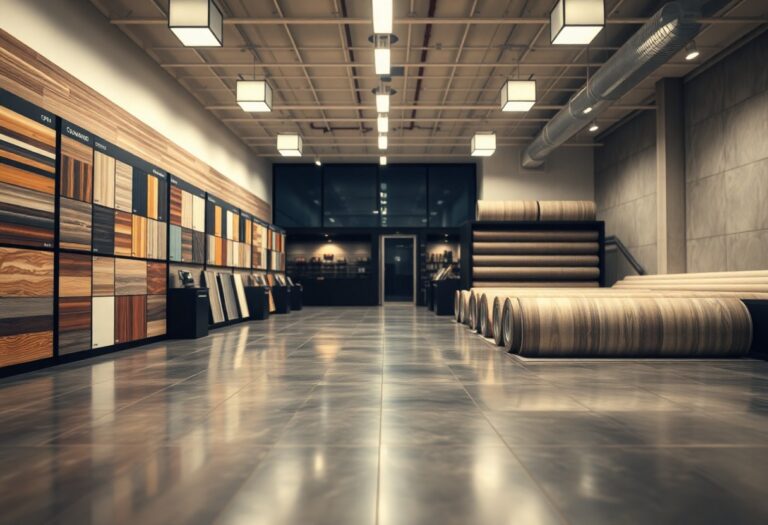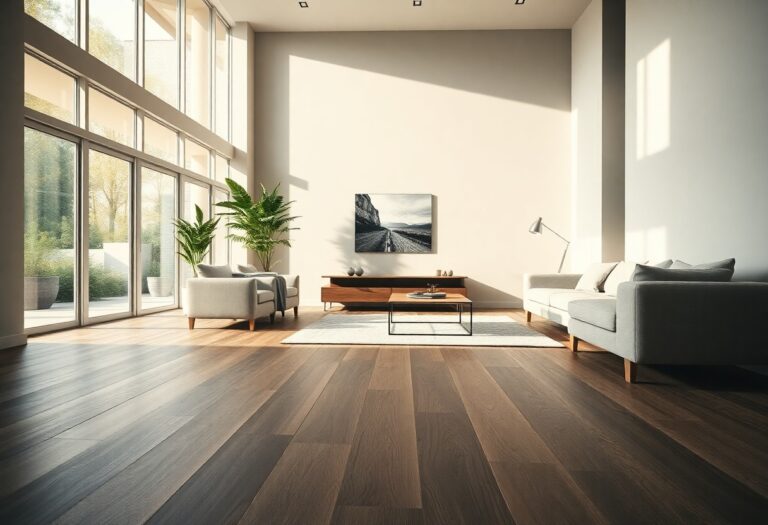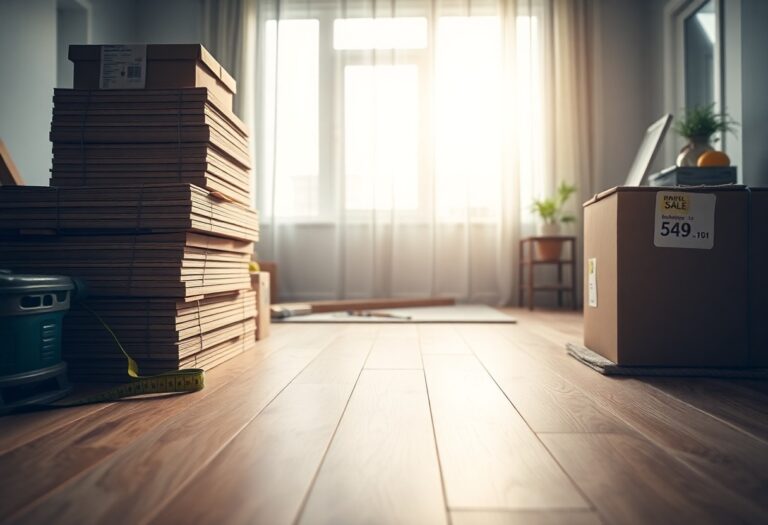Over the years, choosing the right flooring for your home has become increasingly vital, especially in Kitchener’s unique climate. Vinyl and engineered flooring each offer distinct advantages that cater to your lifestyle and preferences. Understanding the differences between these two options will help you make an informed decision, ensuring your floors not only enhance your home’s aesthetics but also meet practical needs. This guide will navigate you through the pros and cons of both flooring types, empowering you to select the best fit for your living space.
Understanding Vinyl Flooring
Vinyl flooring has gained popularity due to its durability, affordability, and aesthetic versatility. Available in various styles and designs, it can mimic the appearance of wood, stone, or tile, making it suitable for any interior. Its moisture resistance and ease of maintenance make it a preferred choice for kitchens and bathrooms, catering to the needs of busy households.
Composition and Structure
Vinyl flooring is composed of layers that contribute to its strength and design capabilities. The base layer provides stability, while the core layer adds resilience and durability. A printed design layer offers a wide range of styles, and a wear layer protects against scratches and stains. This multi-layered structure ensures that you receive both aesthetics and functionality in your flooring choice.
Benefits of Vinyl Flooring
Vinyl flooring offers numerous advantages, particularly for family-oriented spaces like kitchens. Its water resistance makes it ideal for high-moisture areas, and maintenance is straightforward—regular sweeping and occasional mopping keep it looking fresh. You can also enjoy the comfort of walking on vinyl, which tends to be softer underfoot compared to harder flooring options.
In addition to its ease of maintenance, vinyl flooring is also cost-effective, often available at a fraction of the price of hardwood or tile. Installation is typically straightforward, allowing homeowners to save on labor costs. Moreover, its wide range of styles and patterns means you can easily find a design that complements your kitchen aesthetics, enhancing your home’s overall appeal without breaking the bank.
Exploring Engineered Flooring
Engineered flooring is a popular choice for homeowners looking for a combination of beauty and practicality. This flooring type consists of multiple layers that create stability and appealing design. Manufactured with a top hardwood veneer layer, engineered flooring offers the look of real wood while being more resistant to humidity and temperature changes, making it suitable for various areas in your home.
Composition and Construction
Engineered flooring is constructed with a core made of high-quality plywood, HDF, or other materials, layered beneath a hardwood veneer. This unique multi-layer design offers enhanced structural integrity and minimizes the effects of moisture compared to solid wood flooring. The top layer provides an authentic wood appearance, while the underlying layers support durability and adaptability.
Advantages of Engineered Flooring
Choosing engineered flooring presents numerous advantages. Its resistance to warping and swelling makes it ideal for areas with varying humidity levels, such as kitchens and basements. Installation is often more straightforward, as many options feature click-lock systems, allowing for easy DIY projects. Additionally, engineered flooring is available in a wide range of styles and finishes, ensuring you can find the perfect match for your interior design.
Engineered flooring’s versatility extends beyond aesthetics; it can contribute to a more sustainable home. Many products are made from reclaimed wood or sourced from responsibly managed forests, aligning with eco-friendly practices. Moreover, the ability to refinish the veneer a few times adds to its longevity, making it a viable, cost-effective option over the years. This combination of style, resilience, and sustainability makes engineered flooring an attractive choice for modern living in Kitchener.
Comparison of Vinyl and Engineered Flooring
| Vinyl Flooring | Engineered Flooring |
|---|---|
| Water-resistant and ideal for kitchens | More susceptible to moisture |
| Soft underfoot and quieter | Harder surface with less sound insulation |
| Variety of designs and styles | Authentic hardwood appearance |
| Easier and cheaper to install | Requires skilled installation |
Durability and Longevity
Vinyl flooring can last 10 to 20 years with proper care, offering exceptional resistance to scratches and stains. Meanwhile, engineered flooring, composed of real wood veneer over plywood, can endure for 20 to 30 years, depending largely on maintenance and environmental conditions. High-quality engineered options can stand up to moisture better than traditional hardwood but may still require care to maintain their longevity.
Maintenance and Cleaning
Your maintenance routine for vinyl flooring is straightforward, typically requiring only regular sweeping and occasional mopping with a damp cloth. Engineered flooring demands more attention, as using the wrong cleaning products can damage the finish. Keeping it clean may involve using specific hardwood cleaners and ensuring water doesn’t sit on the surface.
Vinyl flooring’s simple maintenance makes it a convenient choice for busy households. You can easily handle spills and stains without worry, as most vinyl products are designed to resist staining and require minimal product use. On the other hand, engineered flooring benefits from occasional refinishing to restore its luster, which adds to its upkeep. Consider investing in specialized cleaning solutions to extend its life while maintaining aesthetic appeal, ensuring your floor continues to look great amidst daily wear and tear.

Aesthetic Appeal and Design Options
Aesthetic appeal plays a significant role in selecting the right flooring for your kitchen. Both vinyl and engineered flooring offer unique styles that can enhance your space. You can find options that mimic the look of natural wood or stone, as well as contemporary finishes that align with modern design trends. Your choice should reflect your personal taste while complementing your kitchen’s overall design.
Style Versatility
You have plenty of versatility with both vinyl and engineered flooring styles. From rustic farmhouse to sleek modern aesthetics, both flooring types provide myriad designs to fit your kitchen’s theme. Engineered flooring can bring out the richness of real wood, while vinyl can offer a broader range of creative patterns and textures, enabling you to achieve the look you desire.
Color and Texture Choices
In the context of color and texture, the options with vinyl and engineered flooring are extensive. Vinyl often features vibrant hues and intricate designs that can be customized to suit any kitchen style. Engineered flooring showcases natural wood variations, allowing you to choose from a wide selection of wood species, stains, and finishes, bringing warmth and richness to your kitchen.
The color and texture choices you encounter can dramatically shape your kitchen’s ambiance. Vinyl flooring typically offers a wide range of colors—from bold, modern tones to classic neutrals—accommodating various design preferences. On the other hand, engineered flooring reveals the beauty of natural hardwood, allowing for options like oak, maple, or hickory, each available in multiple stains and finishes. This flexibility ensures you can find a perfect fit that complements your cabinetry, countertops, and overall decor.
Cost Considerations
Assessing the overall cost of vinyl versus engineered flooring involves evaluating both initial investment and long-term value. Each option presents different price points and benefits that can significantly impact your budget and lifestyle in Kitchener.
Initial Investment
Vinyl flooring typically has a lower upfront cost, averaging between $2 to $7 per square foot, making it accessible for budget-conscious homeowners. In contrast, engineered flooring ranges from $3 to $15 per square foot, depending on the quality and thickness of the veneer. This initial investment plays a significant role in your overall flooring decision.
Long-term Value
Long-term value encompasses durability and maintenance costs over time. Engineered flooring, while more expensive initially, tends to last longer and may require less frequent replacement, providing more substantial returns on investment. Vinyl flooring can be cost-effective short-term but might need replacement sooner, leading to higher costs down the line.
Investing in engineered flooring can yield significant long-term benefits, especially given its resistance to scratching and denting, which often leads to longer lifespans compared to vinyl. With proper maintenance, engineered flooring can endure for 30 years or more, making it a sound investment. Additionally, if your home appreciates in value due to upper-market upgrades like engineered flooring, the potential for higher resale returns becomes increasingly enticing. Thus, allocating a higher budget for engineered flooring often results in saving money over time, particularly in high-traffic areas like kitchens.
Environmental Impact
The environmental impact of flooring materials is increasingly important for homeowners focused on sustainability. Both vinyl and engineered flooring present unique challenges and benefits, influencing your choice. Awareness of these factors can guide you toward a flooring option that meets both your aesthetic preferences and ecological standards.
Sustainability of Materials
Engineered flooring typically features a core made from recycled wood products, promoting resource conservation. In contrast, vinyl flooring derives from petroleum-based materials, raising concerns over fossil fuel consumption and carbon emissions. Choosing engineered options may better align with eco-friendly values, as they promote the use of sustainable materials and responsible forestry practices.
Recycling and Disposal Options
Engineered flooring presents more viable recycling options compared to vinyl, which often ends up in landfills due to limited recycling infrastructure. Many municipalities now accept engineered wood for recycling, enabling more sustainable disposal practices. In contrast, recycling facilities for vinyl are still developing, leaving you with fewer choices at the end of its lifespan.
For engineered flooring, you can often find local programs that repurpose wood fibers, making reuse an attractive option. Brands may also offer take-back programs for their products, helping you avoid landfill waste. Conversely, vinyl flooring recycling is hindered by the lack of processing centers. Although some initiatives are emerging, countless vinyl products remain discarded, underscoring the importance of considering long-term impacts when selecting your flooring material. Choosing engineered options not only supports better recycling prospects but can also contribute to a more sustainable home environment.
Summing up
Conclusively, when deciding between vinyl flooring and engineered flooring for your Kitchener home, consider your lifestyle, budget, and aesthetic preferences. Vinyl offers affordability and water resistance, making it ideal for high-moisture areas like kitchens. On the other hand, engineered flooring provides a touch of elegance and warmth, suitable for those prioritizing natural beauty. Assessing your specific needs will help you make an informed choice that enhances your living space while remaining functional and stylish.





